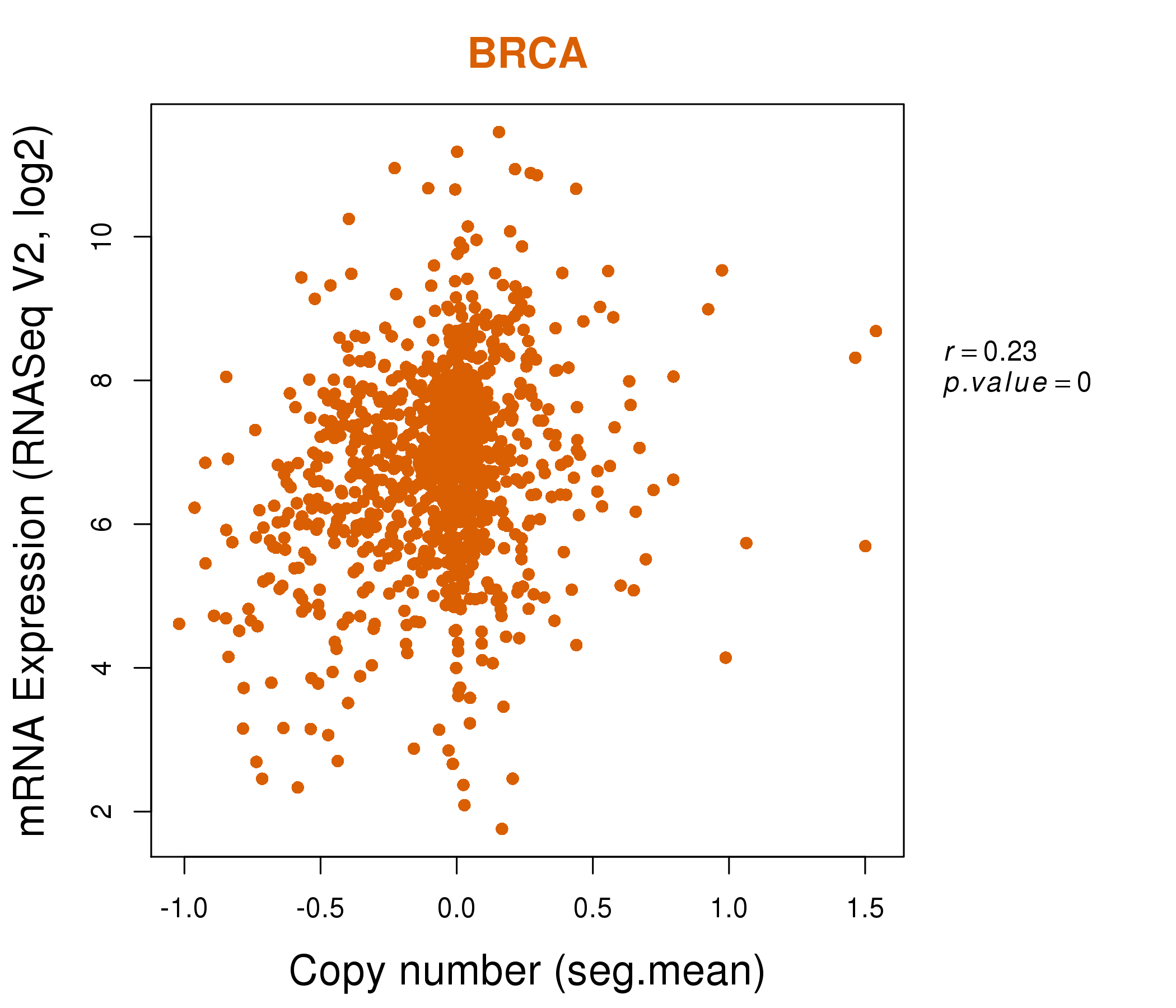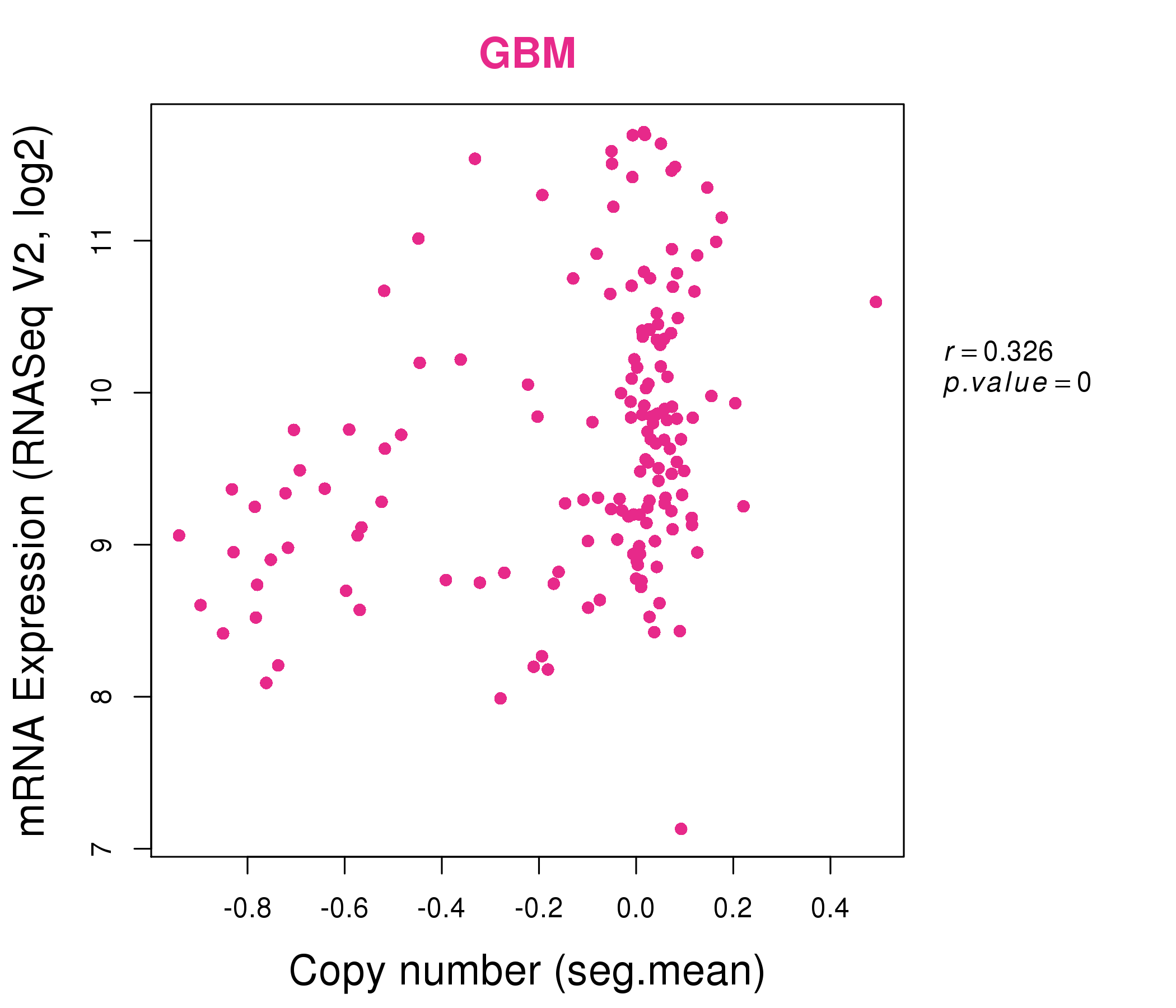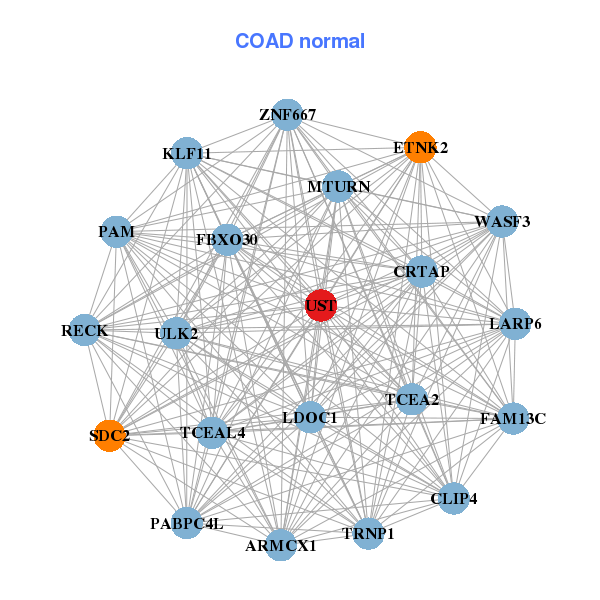|
|||||||||||||||||||||||||||||||||||||||||||||||||||||||||||||||||||||||||||||||||||||||||||||||||||||||||||||||||||||||||||||||||||||||||||||||||||||||||||||||||||||||||||||||||||||||||||||||||||||||||||||||||||||||||||||||||||||||||||||||||||||||||||||||||||||||||||||||||||||||||||||||||||||||||||||||||||||||||||||||||||||||||||||
| |
| Phenotypic Information (metabolism pathway, cancer, disease, phenome) |
| |
| |
| Gene-Gene Network Information: Co-Expression Network, Interacting Genes & KEGG |
| |
|
| Gene Summary for UST |
| Basic gene info. | Gene symbol | UST |
| Gene name | uronyl-2-sulfotransferase | |
| Synonyms | 2OST | |
| Cytomap | UCSC genome browser: 6q25.1 | |
| Genomic location | chr6 :149068270-149398126 | |
| Type of gene | protein-coding | |
| RefGenes | NM_005715.2, | |
| Ensembl id | ENSG00000111962 | |
| Description | dermatan/chondroitin sulfate 2-sulfotransferaseuronyl 2-sulfotransferase | |
| Modification date | 20141207 | |
| dbXrefs | MIM : 610752 | |
| HGNC : HGNC | ||
| Ensembl : ENSG00000111962 | ||
| HPRD : 10298 | ||
| Vega : OTTHUMG00000016135 | ||
| Protein | UniProt: go to UniProt's Cross Reference DB Table | |
| Expression | CleanEX: HS_UST | |
| BioGPS: 10090 | ||
| Gene Expression Atlas: ENSG00000111962 | ||
| The Human Protein Atlas: ENSG00000111962 | ||
| Pathway | NCI Pathway Interaction Database: UST | |
| KEGG: UST | ||
| REACTOME: UST | ||
| ConsensusPathDB | ||
| Pathway Commons: UST | ||
| Metabolism | MetaCyc: UST | |
| HUMANCyc: UST | ||
| Regulation | Ensembl's Regulation: ENSG00000111962 | |
| miRBase: chr6 :149,068,270-149,398,126 | ||
| TargetScan: NM_005715 | ||
| cisRED: ENSG00000111962 | ||
| Context | iHOP: UST | |
| cancer metabolism search in PubMed: UST | ||
| UCL Cancer Institute: UST | ||
| Assigned class in ccmGDB | C | |
| Top |
| Phenotypic Information for UST(metabolism pathway, cancer, disease, phenome) |
| Cancer | CGAP: UST |
| Familial Cancer Database: UST | |
| * This gene is included in those cancer gene databases. |
|
|
|
|
|
| . | |||||||||||||||||||||||||||||||||||||||||||||||||||||||||||||||||||||||||||||||||||||||||||||||||||||||||||||||||||||||||||||||||||||||||||||||||||||||||||||||||||||||||||||||||||||||||||||||||||||||||||||||||||||||||||||||||||||||||||||||||||||||||||||||||||||||||||||||||||||||||||||||||||||||||||||||||||||||||||||||||||||||
Oncogene 1 | Significant driver gene in | ||||||||||||||||||||||||||||||||||||||||||||||||||||||||||||||||||||||||||||||||||||||||||||||||||||||||||||||||||||||||||||||||||||||||||||||||||||||||||||||||||||||||||||||||||||||||||||||||||||||||||||||||||||||||||||||||||||||||||||||||||||||||||||||||||||||||||||||||||||||||||||||||||||||||||||||||||||||||||||||||||||||||||||
| cf) number; DB name 1 Oncogene; http://nar.oxfordjournals.org/content/35/suppl_1/D721.long, 2 Tumor Suppressor gene; https://bioinfo.uth.edu/TSGene/, 3 Cancer Gene Census; http://www.nature.com/nrc/journal/v4/n3/abs/nrc1299.html, 4 CancerGenes; http://nar.oxfordjournals.org/content/35/suppl_1/D721.long, 5 Network of Cancer Gene; http://ncg.kcl.ac.uk/index.php, 1Therapeutic Vulnerabilities in Cancer; http://cbio.mskcc.org/cancergenomics/statius/ |
| REACTOME_METABOLISM_OF_CARBOHYDRATES | |
| OMIM | |
| Orphanet | |
| Disease | KEGG Disease: UST |
| MedGen: UST (Human Medical Genetics with Condition) | |
| ClinVar: UST | |
| Phenotype | MGI: UST (International Mouse Phenotyping Consortium) |
| PhenomicDB: UST | |
| Mutations for UST |
| * Under tables are showing count per each tissue to give us broad intuition about tissue specific mutation patterns.You can go to the detailed page for each mutation database's web site. |
| - Statistics for Tissue and Mutation type | Top |
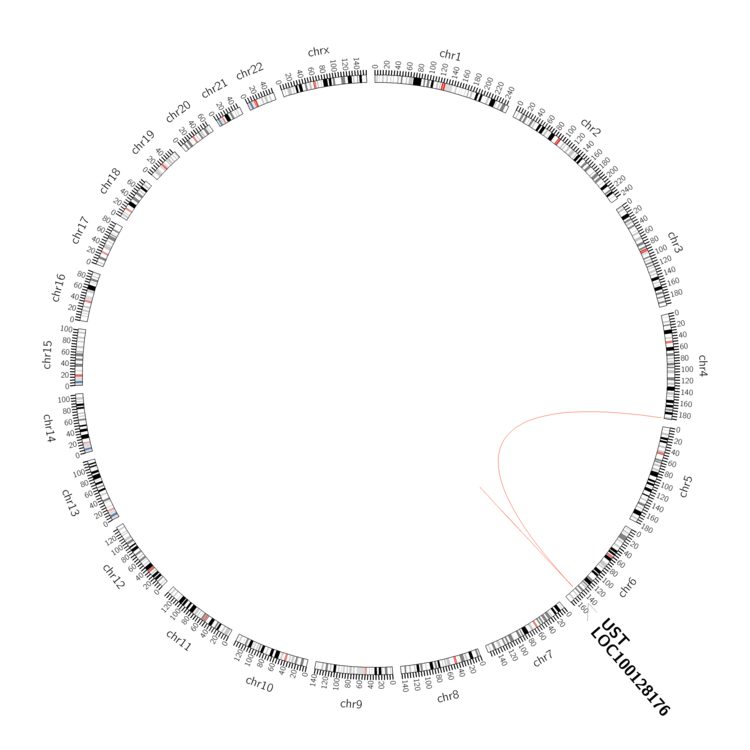 |
| - For Inter-chromosomal Variations |
| * Inter-chromosomal variantions includes 'interchromosomal amplicon to amplicon', 'interchromosomal amplicon to non-amplified dna', 'interchromosomal insertion', 'Interchromosomal unknown type'. |
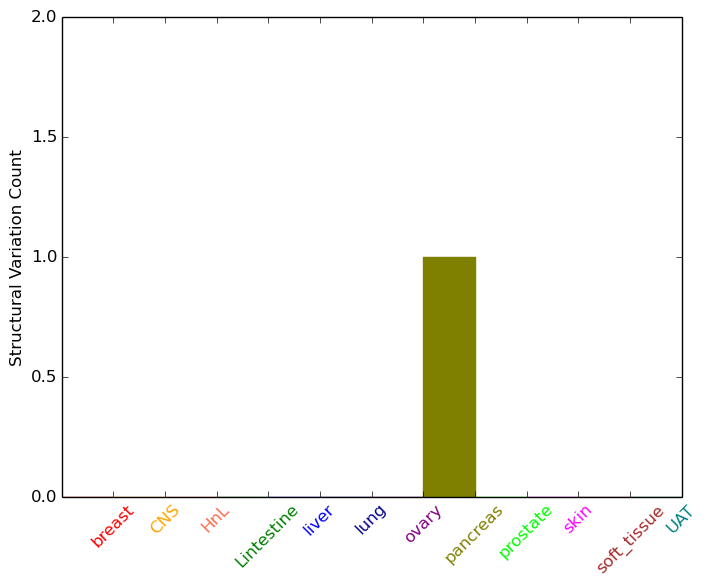 |
| - For Intra-chromosomal Variations |
| * Intra-chromosomal variantions includes 'intrachromosomal amplicon to amplicon', 'intrachromosomal amplicon to non-amplified dna', 'intrachromosomal deletion', 'intrachromosomal fold-back inversion', 'intrachromosomal inversion', 'intrachromosomal tandem duplication', 'Intrachromosomal unknown type', 'intrachromosomal with inverted orientation', 'intrachromosomal with non-inverted orientation'. |
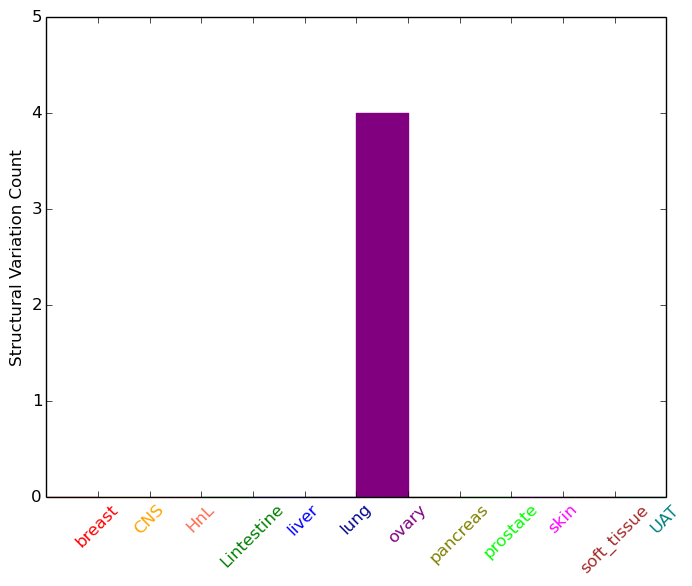 |
| Sample | Symbol_a | Chr_a | Start_a | End_a | Symbol_b | Chr_b | Start_b | End_b |
| ovary | UST | chr6 | 149269407 | 149269427 | UST | chr6 | 149261281 | 149261301 |
| ovary | UST | chr6 | 149287297 | 149287317 | UST | chr6 | 149287385 | 149287405 |
| pancreas | UST | chr6 | 149074907 | 149074927 | chr4 | 190574198 | 190574218 |
| cf) Tissue number; Tissue name (1;Breast, 2;Central_nervous_system, 3;Haematopoietic_and_lymphoid_tissue, 4;Large_intestine, 5;Liver, 6;Lung, 7;Ovary, 8;Pancreas, 9;Prostate, 10;Skin, 11;Soft_tissue, 12;Upper_aerodigestive_tract) |
| * From mRNA Sanger sequences, Chitars2.0 arranged chimeric transcripts. This table shows UST related fusion information. |
| ID | Head Gene | Tail Gene | Accession | Gene_a | qStart_a | qEnd_a | Chromosome_a | tStart_a | tEnd_a | Gene_a | qStart_a | qEnd_a | Chromosome_a | tStart_a | tEnd_a |
| BF873230 | UST | 37 | 73 | 6 | 149332344 | 149332799 | ACVR1 | 69 | 132 | 2 | 158695222 | 158695285 | |
| DA572991 | UST | 1 | 323 | 6 | 149202980 | 149203302 | CNKSR3 | 320 | 803 | 6 | 154778110 | 154778592 | |
| Top |
| Mutation type/ Tissue ID | brca | cns | cerv | endome | haematopo | kidn | Lintest | liver | lung | ns | ovary | pancre | prost | skin | stoma | thyro | urina | |||
| Total # sample | 5 | 1 | ||||||||||||||||||
| GAIN (# sample) | 5 | 1 | ||||||||||||||||||
| LOSS (# sample) |
| cf) Tissue ID; Tissue type (1; Breast, 2; Central_nervous_system, 3; Cervix, 4; Endometrium, 5; Haematopoietic_and_lymphoid_tissue, 6; Kidney, 7; Large_intestine, 8; Liver, 9; Lung, 10; NS, 11; Ovary, 12; Pancreas, 13; Prostate, 14; Skin, 15; Stomach, 16; Thyroid, 17; Urinary_tract) |
| Top |
|
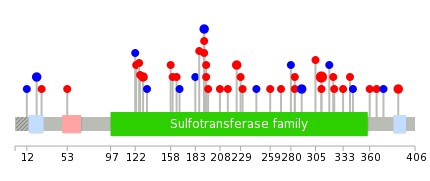 |
| Top |
| Stat. for Non-Synonymous SNVs (# total SNVs=31) | (# total SNVs=14) |
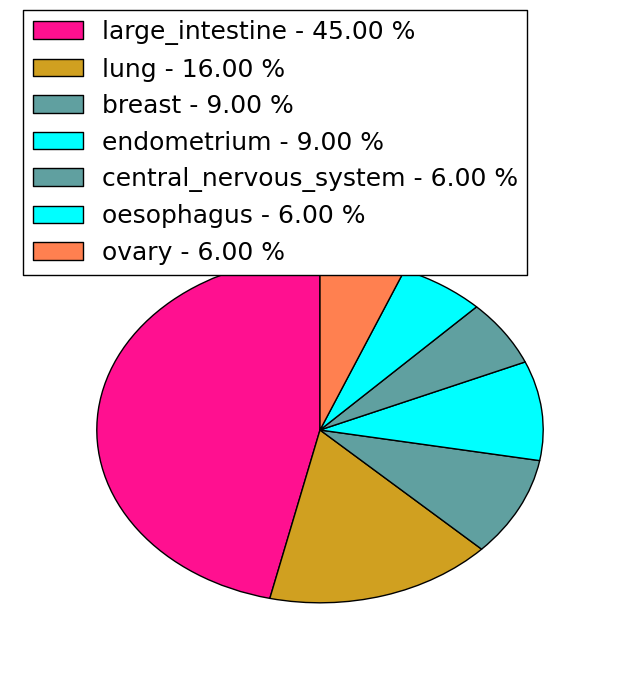 | 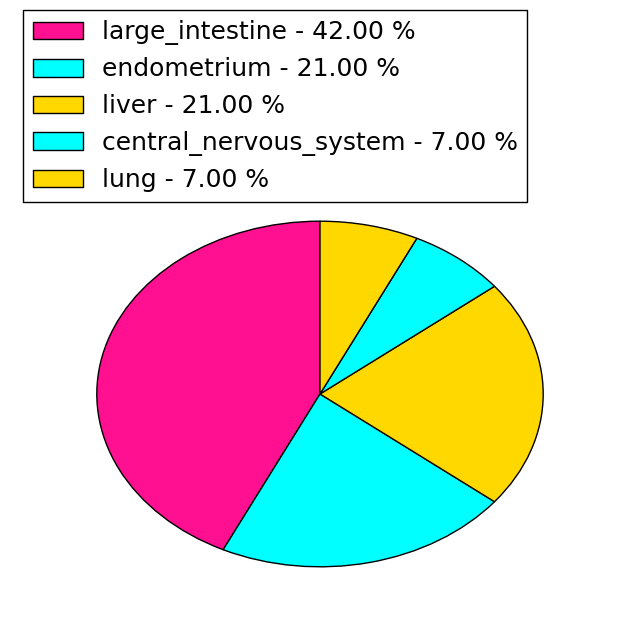 |
(# total SNVs=0) | (# total SNVs=1) |
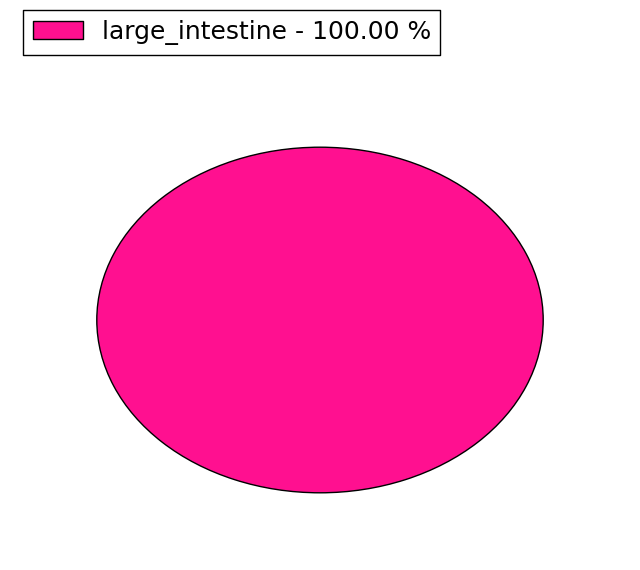 |
| Top |
| * When you move the cursor on each content, you can see more deailed mutation information on the Tooltip. Those are primary_site,primary_histology,mutation(aa),pubmedID. |
| GRCh37 position | Mutation(aa) | Unique sampleID count |
| chr6:149342612-149342612 | p.D311G | 5 |
| chr6:149262511-149262511 | p.G130R | 2 |
| chr6:149285594-149285594 | p.V192V | 2 |
| chr6:149068632-149068632 | p.G22G | 2 |
| chr6:149342530-149342530 | p.L284F | 2 |
| chr6:149342551-149342551 | p.L291L | 2 |
| chr6:149285691-149285691 | p.R225C | 2 |
| chr6:149395197-149395197 | p.I389N | 2 |
| chr6:149285593-149285593 | p.V192A | 1 |
| chr6:149340328-149340328 | p.L245L | 1 |
| Top |
|
 |
| Point Mutation/ Tissue ID | 1 | 2 | 3 | 4 | 5 | 6 | 7 | 8 | 9 | 10 | 11 | 12 | 13 | 14 | 15 | 16 | 17 | 18 | 19 | 20 |
| # sample | 1 | 3 | 16 | 1 | 1 | 4 | 1 | 2 | 1 | 1 | 9 | 6 | ||||||||
| # mutation | 1 | 3 | 11 | 1 | 1 | 4 | 1 | 2 | 1 | 1 | 9 | 6 | ||||||||
| nonsynonymous SNV | 1 | 3 | 6 | 1 | 1 | 3 | 1 | 2 | 1 | 8 | 3 | |||||||||
| synonymous SNV | 5 | 1 | 1 | 1 | 3 |
| cf) Tissue ID; Tissue type (1; BLCA[Bladder Urothelial Carcinoma], 2; BRCA[Breast invasive carcinoma], 3; CESC[Cervical squamous cell carcinoma and endocervical adenocarcinoma], 4; COAD[Colon adenocarcinoma], 5; GBM[Glioblastoma multiforme], 6; Glioma Low Grade, 7; HNSC[Head and Neck squamous cell carcinoma], 8; KICH[Kidney Chromophobe], 9; KIRC[Kidney renal clear cell carcinoma], 10; KIRP[Kidney renal papillary cell carcinoma], 11; LAML[Acute Myeloid Leukemia], 12; LUAD[Lung adenocarcinoma], 13; LUSC[Lung squamous cell carcinoma], 14; OV[Ovarian serous cystadenocarcinoma ], 15; PAAD[Pancreatic adenocarcinoma], 16; PRAD[Prostate adenocarcinoma], 17; SKCM[Skin Cutaneous Melanoma], 18:STAD[Stomach adenocarcinoma], 19:THCA[Thyroid carcinoma], 20:UCEC[Uterine Corpus Endometrial Carcinoma]) |
| Top |
| * We represented just top 10 SNVs. When you move the cursor on each content, you can see more deailed mutation information on the Tooltip. Those are primary_site, primary_histology, mutation(aa), pubmedID. |
| Genomic Position | Mutation(aa) | Unique sampleID count |
| chr6:149342612 | p.D311G | 5 |
| chr6:149342551 | p.L291L | 3 |
| chr6:149285691 | p.L284I | 2 |
| chr6:149342530 | p.R225C | 2 |
| chr6:149285605 | p.E160K | 1 |
| chr6:149342593 | p.L164V | 1 |
| chr6:149262512 | p.V183V | 1 |
| chr6:149285641 | p.V305M | 1 |
| chr6:149342611 | p.V192I | 1 |
| chr6:149262525 | p.D311H | 1 |
| * Copy number data were extracted from TCGA using R package TCGA-Assembler. The URLs of all public data files on TCGA DCC data server were gathered on Jan-05-2015. Function ProcessCNAData in TCGA-Assembler package was used to obtain gene-level copy number value which is calculated as the average copy number of the genomic region of a gene. |
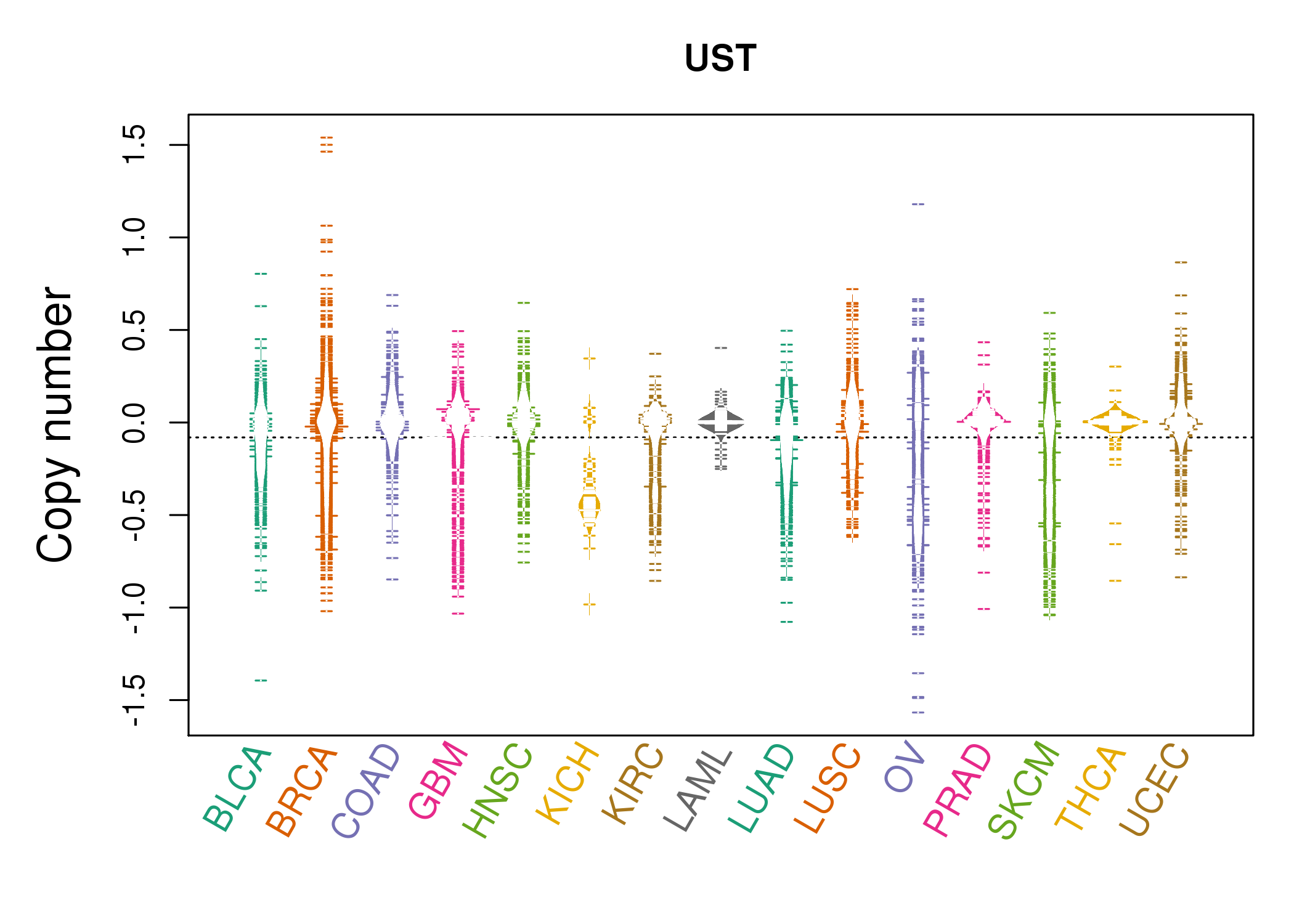 |
| cf) Tissue ID[Tissue type]: BLCA[Bladder Urothelial Carcinoma], BRCA[Breast invasive carcinoma], CESC[Cervical squamous cell carcinoma and endocervical adenocarcinoma], COAD[Colon adenocarcinoma], GBM[Glioblastoma multiforme], Glioma Low Grade, HNSC[Head and Neck squamous cell carcinoma], KICH[Kidney Chromophobe], KIRC[Kidney renal clear cell carcinoma], KIRP[Kidney renal papillary cell carcinoma], LAML[Acute Myeloid Leukemia], LUAD[Lung adenocarcinoma], LUSC[Lung squamous cell carcinoma], OV[Ovarian serous cystadenocarcinoma ], PAAD[Pancreatic adenocarcinoma], PRAD[Prostate adenocarcinoma], SKCM[Skin Cutaneous Melanoma], STAD[Stomach adenocarcinoma], THCA[Thyroid carcinoma], UCEC[Uterine Corpus Endometrial Carcinoma] |
| Top |
| Gene Expression for UST |
| * CCLE gene expression data were extracted from CCLE_Expression_Entrez_2012-10-18.res: Gene-centric RMA-normalized mRNA expression data. |
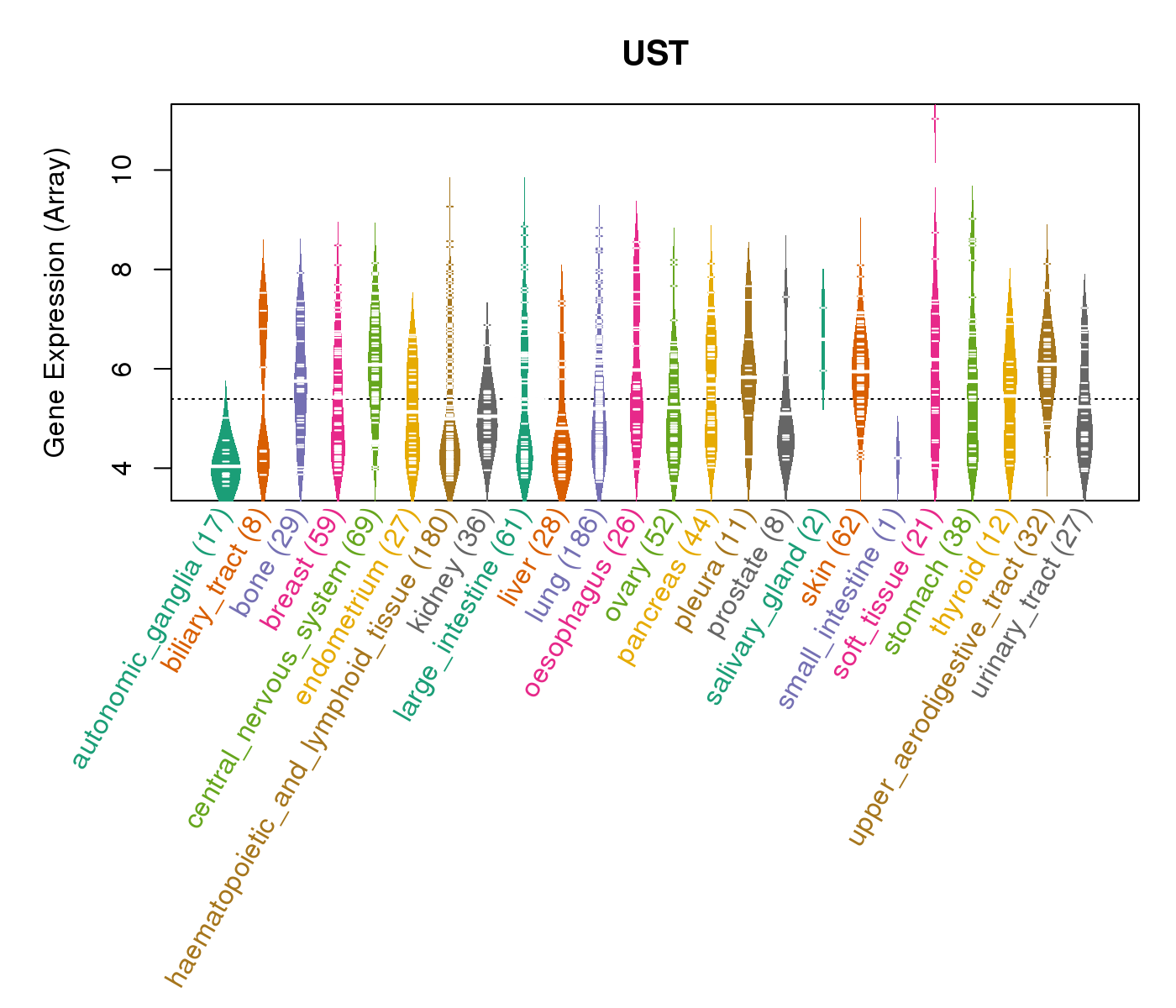 |
| * Normalized gene expression data of RNASeqV2 was extracted from TCGA using R package TCGA-Assembler. The URLs of all public data files on TCGA DCC data server were gathered at Jan-05-2015. Only eight cancer types have enough normal control samples for differential expression analysis. (t test, adjusted p<0.05 (using Benjamini-Hochberg FDR)) |
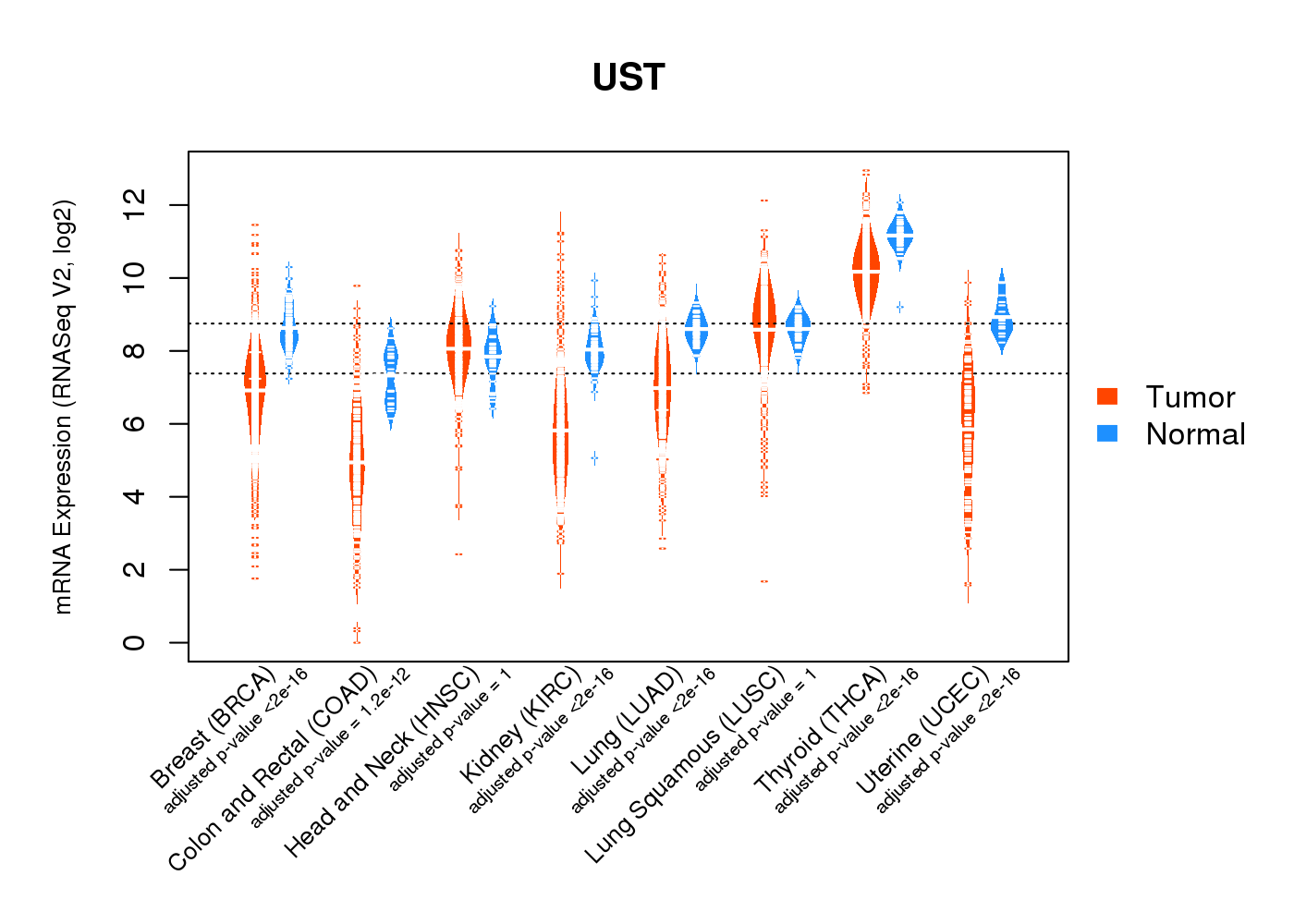 |
| Top |
| * This plots show the correlation between CNV and gene expression. |
: Open all plots for all cancer types
 |
|
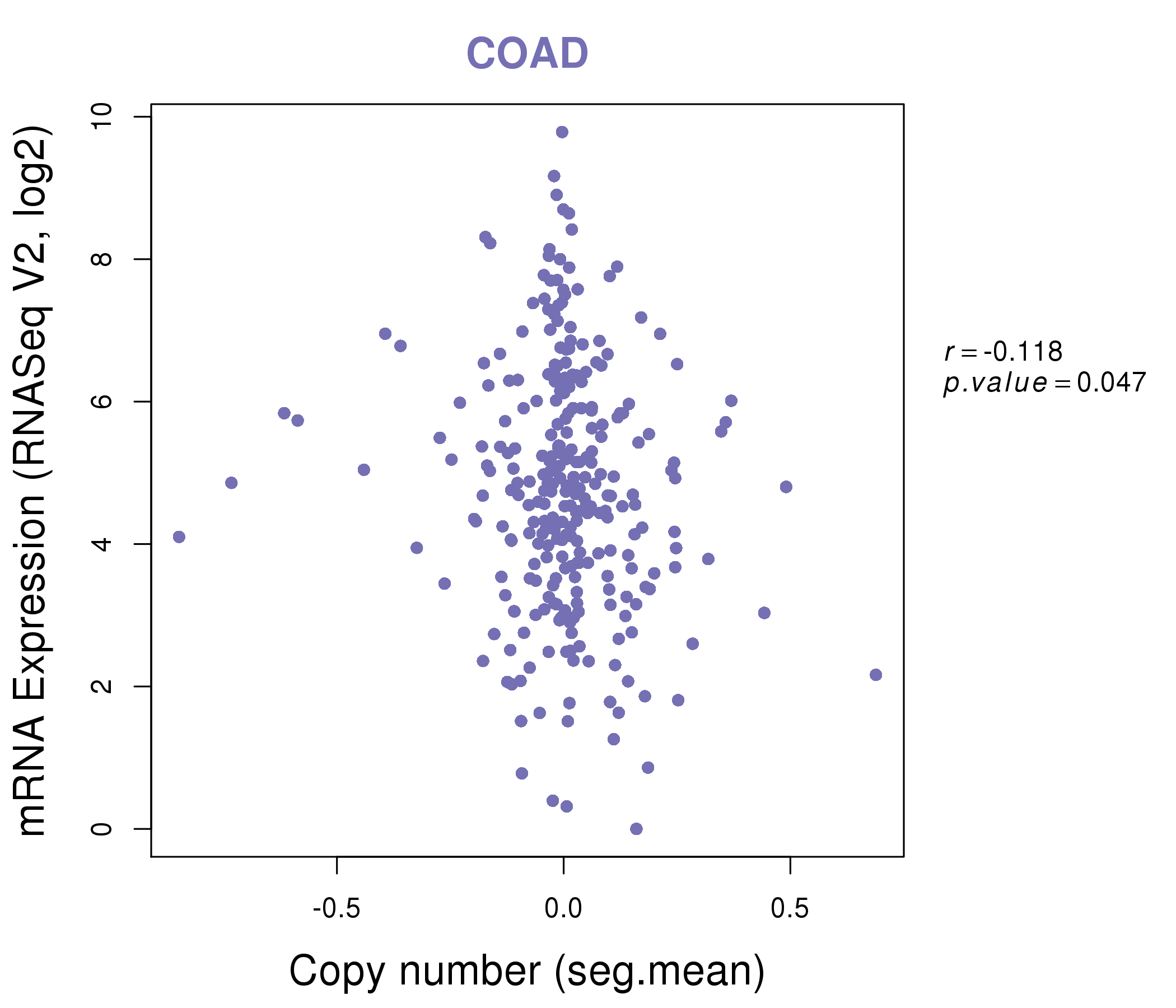 |
|
| Top |
| Gene-Gene Network Information |
| * Co-Expression network figures were drawn using R package igraph. Only the top 20 genes with the highest correlations were shown. Red circle: input gene, orange circle: cell metabolism gene, sky circle: other gene |
: Open all plots for all cancer types
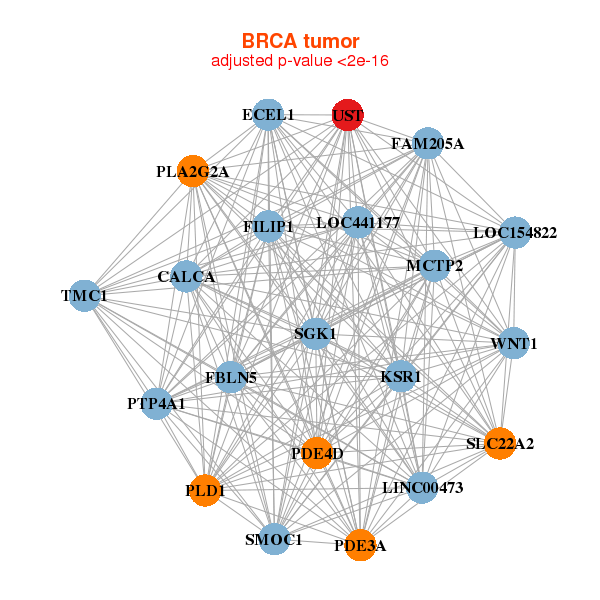 |
| ||||
| LINC00473,FAM205A,CALCA,ECEL1,FBLN5,FILIP1,KSR1, LOC154822,LOC441177,MCTP2,PDE3A,PDE4D,PLA2G2A,PLD1, PTP4A1,SGK1,SLC22A2,SMOC1,TMC1,UST,WNT1 | ABI3BP,CDON,CYBRD1,DCN,FGL2,GALNT12,GAS1, KDELC2,LPAR1,MFAP4,NT5E,OGN,OLFML1,OMD, PAM,PID1,PTGFR,RECK,TIMP2,UST,XG | ||||
 |
| ||||
| BPESC1,C4orf51,CA7,CCL26,CRYBA4,HCN2,HELT, ISYNA1,LAG3,NXPH4,TINCR,PNMA1,PPM1K,PRB1, PRB2,RNF144B,TRIB2,TRIM69,UST,VAMP2,ZNF385A | ARMCX1,MTURN,CLIP4,CRTAP,ETNK2,FAM13C,FBXO30, KLF11,LARP6,LDOC1,PABPC4L,PAM,RECK,SDC2, TCEA2,TCEAL4,TRNP1,ULK2,UST,WASF3,ZNF667 |
| * Co-Expression network figures were drawn using R package igraph. Only the top 20 genes with the highest correlations were shown. Red circle: input gene, orange circle: cell metabolism gene, sky circle: other gene |
: Open all plots for all cancer types
| Top |
: Open all interacting genes' information including KEGG pathway for all interacting genes from DAVID
| Top |
| Pharmacological Information for UST |
| DB Category | DB Name | DB's ID and Url link |
| * Gene Centered Interaction Network. |
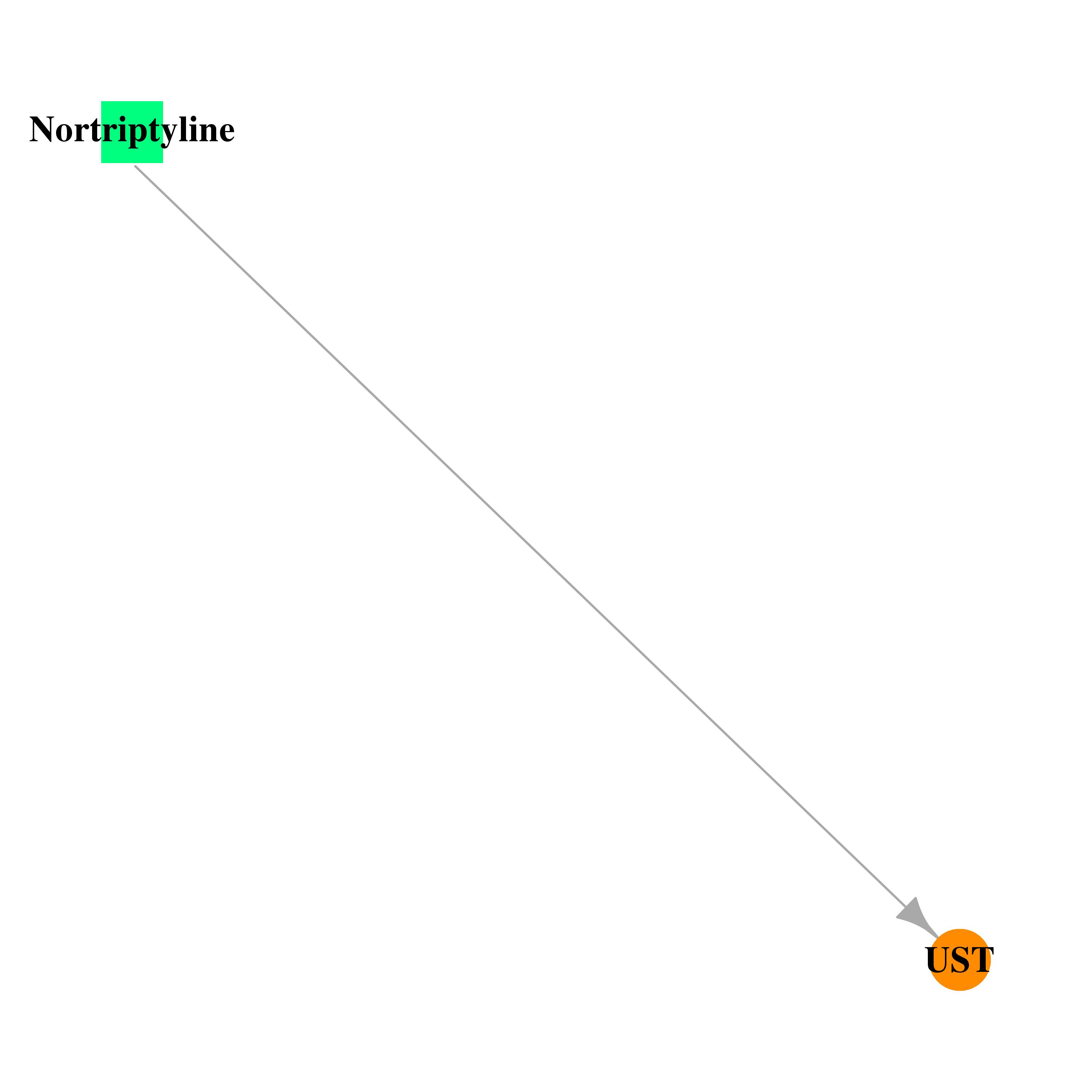 |
| * Drug Centered Interaction Network. |
| DrugBank ID | Target Name | Drug Groups | Generic Name | Drug Centered Network | Drug Structure |
| DB00540 | uronyl-2-sulfotransferase | approved | Nortriptyline | 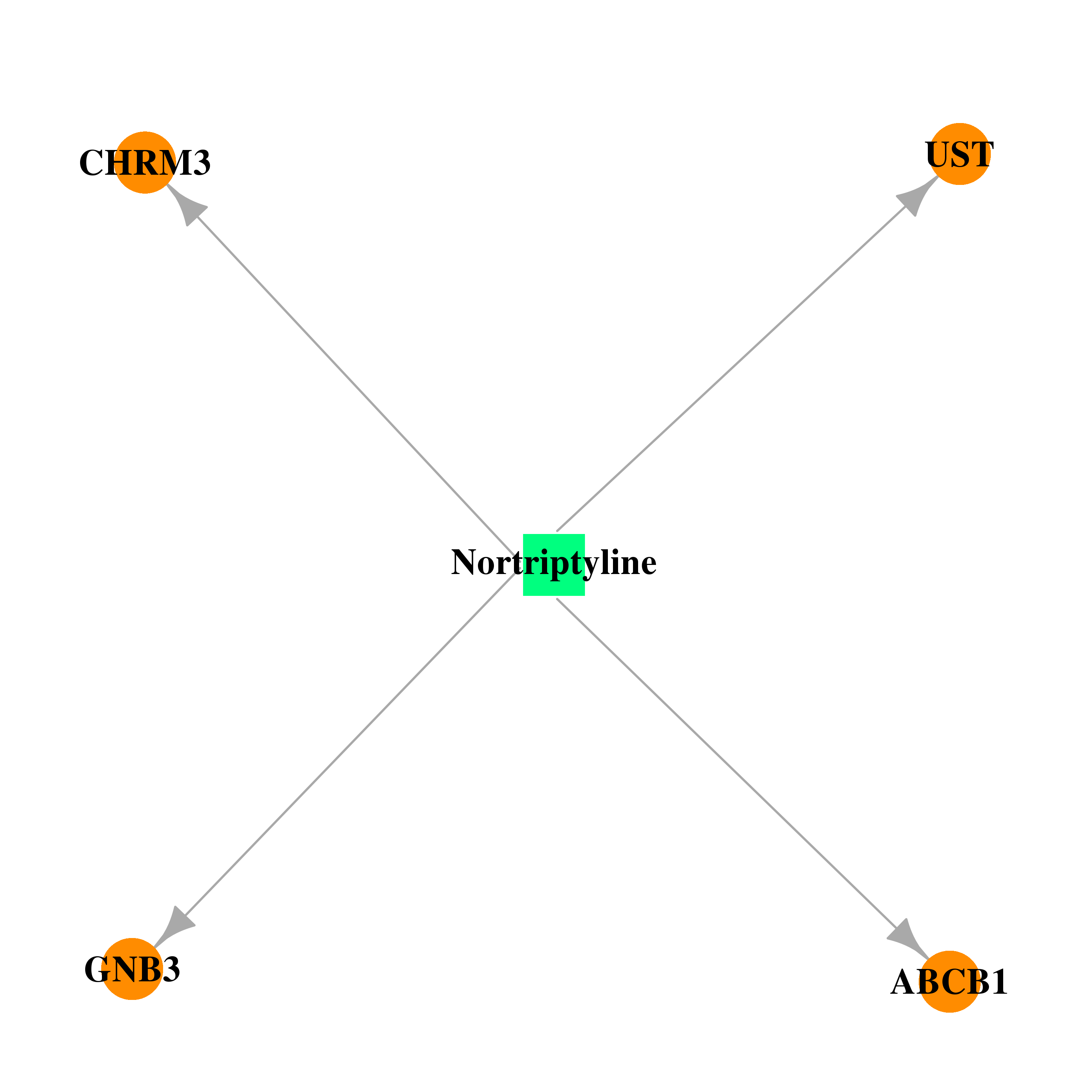 |  |
| Top |
| Cross referenced IDs for UST |
| * We obtained these cross-references from Uniprot database. It covers 150 different DBs, 18 categories. http://www.uniprot.org/help/cross_references_section |
: Open all cross reference information
|
Copyright © 2016-Present - The Univsersity of Texas Health Science Center at Houston @ |






